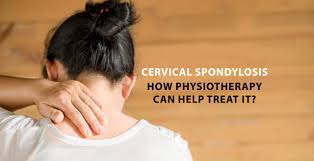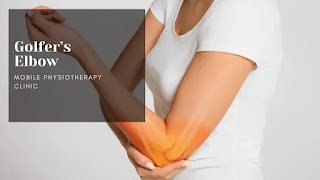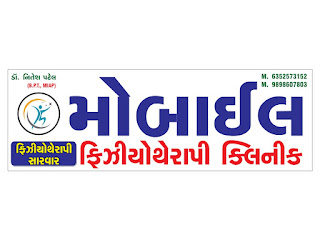What is Cervical spondylosis?
 |
| Cervical spondylosis |
Cervical spondylosis is a medical condition that refers to the age-related wear and tear of the cervical spine (the uppermost part of the spine located in the neck). It is a degenerative condition that affects the vertebral bones, intervertebral discs, and surrounding structures such as ligaments and muscles.
The degeneration of the cervical spine can lead to the development of bone spurs (also known as osteophytes) which can impinge on nerves, resulting in pain, numbness, tingling or weakness in the arms, neck, or shoulders. Cervical spondylosis can also cause a reduction in the range of motion of the neck and can lead to headaches.
Cervical spondylosis is commonly seen in people over the age of 40, but it can occur in younger people as well, especially those who have a history of neck injuries or trauma. The condition can be diagnosed through imaging tests such as X-rays, CT scans or MRI scans, and treatment options can include physical therapy, medications, or in some cases, surgery.
Related Anatomy
The cervical spine is made up of seven vertebrae (C1 to C7) that begin at the base of the skull and extend down to the thoracic spine. The cervical spine is responsible for supporting the weight of the head, allowing for head movement and protecting the spinal cord.
Between each of the cervical vertebrae, there is an intervertebral disc, which acts as a cushion to absorb shock and prevent the vertebrae from rubbing against each other. The intervertebral discs are composed of a tough outer layer called the annulus fibrosus and a soft gel-like center called the nucleus pulposus.
The cervical spine is also surrounded by ligaments, which provide stability to the joints between the vertebrae, and muscles, which control the movement of the neck and head. The major muscles of the neck include the sternocleidomastoid, splenius capitis, levator scapulae, and trapezius muscles.
The cervical spine is also home to several important nerves, including the spinal cord, which carries signals from the brain to the rest of the body, and the cervical nerves, which branch off from the spinal cord and innervate the neck, shoulders, arms, and hands.
Causes of Cervical spondylosis
The exact cause of cervical spondylosis is not known, but it is believed to be caused by a combination of factors including age-related degeneration, genetic predisposition, and lifestyle factors. Some of the common causes of cervical spondylosis include:
Age-related wear and tear: As we age, the intervertebral discs in the cervical spine lose their flexibility and become less able to absorb shock. This can lead to the development of bone spurs or osteophytes, which can put pressure on the nerves and cause pain.
Repetitive stress: Repetitive stress on the neck, such as from poor posture or spending long hours in front of a computer, can also contribute to the development of cervical spondylosis.
Neck injuries: Trauma to the neck, such as from a car accident or sports injury, can cause damage to the cervical spine and increase the risk of developing cervical spondylosis.
Genetics: There is some evidence that genetics may play a role in the development of cervical spondylosis, as it tends to run in families.
Smoking: Smoking can accelerate the degenerative process in the cervical spine, increasing the risk of developing cervical spondylosis.
Other risk factors for cervical spondylosis include a sedentary lifestyle, obesity, and a history of heavy lifting.
Symptoms of Cervical spondylosis
The symptoms of cervical spondylosis can vary depending on the severity and location of the degenerative changes in the cervical spine. Some common symptoms of cervical spondylosis include:
Neck pain: Pain in the neck is the most common symptom of cervical spondylosis. The pain may be dull or sharp and may radiate to the shoulders, arms or hands.
Stiffness: The neck may feel stiff or rigid, making it difficult to turn the head or move the neck.
Headaches: Cervical spondylosis can cause tension headaches that start at the base of the skull and radiate to the forehead.
Tingling or numbness: Compression of nerves in the cervical spine can cause tingling or numbness in the shoulders, arms or hands.
Weakness: Compression of nerves can also cause weakness in the muscles of the shoulders, arms or hands.
Loss of balance: In rare cases, severe cervical spondylosis can cause loss of balance or difficulty walking.
The symptoms of cervical spondylosis may worsen with prolonged sitting or standing, and may improve with rest or changes in posture. It's important to seek medical attention if you experience any of these symptoms, as they can be indicative of other conditions as well.
Risk factor for cervical spondylosis
There are several risk factors that increase the likelihood of developing cervical spondylosis. These include:
Age: Cervical spondylosis is more common in people over the age of 40, as the cervical spine undergoes degenerative changes with age.
Genetics: There may be a genetic component to cervical spondylosis, as it tends to run in families.
Occupation and lifestyle: Certain occupations that involve repetitive stress on the neck, such as computer work, can increase the risk of developing cervical spondylosis. A sedentary lifestyle, lack of exercise, and obesity can also increase the risk.
Trauma: Previous neck injuries, such as those sustained in car accidents or sports, can increase the risk of cervical spondylosis.
Smoking: Smoking has been shown to accelerate the degenerative changes in the cervical spine, increasing the risk of cervical spondylosis.
Other medical conditions: Certain medical conditions, such as rheumatoid arthritis, can increase the risk of developing cervical spondylosis.
It's important to note that having one or more of these risk factors does not necessarily mean that a person will develop cervical spondylosis, but it does increase the likelihood.
Difference Diagnosis
The symptoms of cervical spondylosis can be similar to those of other conditions, so it's important to get a proper diagnosis. Some conditions that can be confused with cervical spondylosis include:
Herniated disc: A herniated disc occurs when the soft gel-like center of an intervertebral disc protrudes through the tough outer layer, putting pressure on the nerves. This can cause similar symptoms to cervical spondylosis.
Spinal stenosis: Spinal stenosis is a narrowing of the spinal canal that can put pressure on the spinal cord and nerves, causing symptoms similar to cervical spondylosis.
Pinched nerve: A pinched nerve can occur anywhere along the path of a nerve, causing pain, numbness, or weakness in the affected area.
Tension headache: Tension headaches can cause pain and stiffness in the neck, which can be mistaken for symptoms of cervical spondylosis.
Fibromyalgia: Fibromyalgia is a chronic pain condition that can cause widespread pain, fatigue, and sleep disturbances, which can be mistaken for symptoms of cervical spondylosis.
To make a differential diagnosis, a doctor may perform a physical exam, take a medical history, and order diagnostic tests, such as X-rays, MRI scans, or nerve conduction studies, to determine the underlying cause of the symptoms.
Diagnosis
To diagnose cervical spondylosis, a doctor may perform the following:
Medical history: The doctor will ask about the patient's symptoms, medical history, and any previous injuries or surgeries.
Physical exam: The doctor will perform a physical exam to assess the range of motion in the neck, strength and sensation in the arms and hands, and any signs of nerve damage.
Imaging tests: Imaging tests such as X-rays, CT scans, or MRI scans can help visualize the extent of the degenerative changes in the cervical spine.
Electromyography (EMG): EMG is a test that measures the electrical activity of muscles and nerves. This test can help determine if there is any nerve damage.
Nerve conduction studies: Nerve conduction studies are tests that measure the speed at which nerves conduct electrical signals. These tests can help determine if there is any nerve damage.
Based on the results of these tests, the doctor can make a diagnosis of cervical spondylosis and determine the severity of the condition. The doctor may also recommend a treatment plan based on the individual patient's needs.
Treatment of Cervical spondylosis
The treatment of cervical spondylosis typically depends on the severity of the condition and the individual patient's symptoms. Some common treatment options include:
Medications: Non-steroidal anti-inflammatory drugs (NSAIDs) can help relieve pain and inflammation. Muscle relaxants can also help relieve muscle spasms. In more severe cases, corticosteroids or opioids may be prescribed.
Physical therapy Treatment: Physical therapy can help improve strength and flexibility in the neck and shoulders. This can help reduce pain and improve mobility.
Neck traction: Neck traction involves the use of weights or a pulley system to gently stretch the neck. This can help relieve pressure on the nerves and improve range of motion.
Cervical collar: A cervical collar may be used to immobilize the neck and relieve pain. This is typically used for short periods of time and under the supervision of a doctor or physical therapist.
Surgery: In severe cases, surgery may be necessary to relieve pressure on the nerves. This may involve removing bone spurs, herniated discs, or other structures that are compressing the nerves.
Lifestyle changes: Making lifestyle changes such as maintaining good posture, avoiding prolonged sitting or standing, and engaging in regular exercise can help improve the symptoms of cervical spondylosis.
It's important to work with a healthcare provider to determine the most appropriate treatment plan for cervical spondylosis, as the severity of the condition can vary from person to person.
Physiotherapy treatment
Physiotherapy can be an effective treatment option for cervical spondylosis. A physiotherapist can design a treatment plan tailored to the individual patient's needs and symptoms. Some common physiotherapy treatments for cervical spondylosis include:
Manual therapy: Manual therapy techniques such as mobilization and manipulation can help improve joint mobility and reduce pain.
Exercise therapy: Exercise therapy can help improve strength, flexibility, and range of motion in the neck and shoulders. This can help reduce pain and improve mobility.
Traction: Cervical traction can help reduce pressure on the nerves and improve range of motion in the neck.
Posture correction: Poor posture can contribute to the development and progression of cervical spondylosis. A physiotherapist can help identify and correct poor posture habits.
Electrical stimulation: Electrical stimulation can be used to reduce pain and improve muscle function.
Heat and cold therapy: Heat therapy can help reduce muscle tension and improve blood flow. Cold therapy can help reduce inflammation and pain.
A physiotherapist may also provide education on self-management strategies, such as ergonomic modifications, stress management techniques, and home exercise programs. Physiotherapy can be an effective and non-invasive treatment option for cervical spondylosis, and can help improve quality of life for individuals with this condition.
Exercises for cervical spondylosis
Before beginning any exercise program for cervical spondylosis, it's important to consult with a healthcare provider or physiotherapist to determine the most appropriate exercises for your individual needs and symptoms. Some common exercises that may be recommended for cervical spondylosis include:
Neck stretches: Slowly turning the head from side to side, tilting the head forward and backward, and rotating the head in a circular motion can help improve range of motion and reduce stiffness in the neck.
Shoulder rolls: Rolling the shoulders forward and backward can help improve mobility and reduce tension in the neck and shoulders.
Chin tucks: Tucking the chin in toward the chest can help improve posture and reduce strain on the neck.
Scapular squeezes: Squeezing the shoulder blades together can help strengthen the muscles of the upper back and improve posture.
Wall angels: Standing with the back against a wall and raising the arms overhead, then lowering them back down, can help improve shoulder mobility and posture.
Resistance band exercises: Using a resistance band to perform exercises such as shoulder rows and shoulder extensions can help strengthen the muscles of the upper back and shoulders.
Isometric neck exercises
 |
| Isometric neck exercises |
Isometric neck exercises can be a helpful addition to a comprehensive exercise program for cervical spondylosis. Isometric exercises involve contracting the muscles without actually moving the joint, which can help improve muscle strength and reduce pain. Some examples of isometric neck exercises for cervical spondylosis include:
Chin tucks: While sitting or standing, tuck your chin in toward your chest and hold the contraction for 5-10 seconds before releasing. Repeat 10-15 times.
Neck extension: While sitting or standing, place your hands behind your head and gently press your head back into your hands. Hold the contraction for 5-10 seconds before releasing. Repeat 10-15 times.
Neck flexion: While sitting or standing, place your hands on your forehead and gently press your head forward into your hands. Hold the contraction for 5-10 seconds before releasing. Repeat 10-15 times.
Lateral neck flexion: While sitting or standing, place your right hand on the side of your head and gently press your head to the right, while resisting with your neck muscles. Hold the contraction for 5-10 seconds before releasing. Repeat on the left side. Repeat 10-15 times on each side.
It's important to start slowly and gradually increase the intensity and duration of exercises over time. As with any exercise program, it's important to consult with a healthcare provider or physiotherapist to determine the most appropriate exercises for your individual needs and symptoms.
How to Prevent Cervical spondylosis?
There is no guaranteed way to prevent cervical spondylosis, as it is often a result of the natural aging process. However, there are several steps you can take to reduce your risk of developing cervical spondylosis or to prevent it from getting worse if you have already been diagnosed. These include:
Practice good posture: Maintaining good posture can help reduce strain on the neck and prevent the development of cervical spondylosis. Keep your head balanced directly over your spine, and avoid hunching forward or slouching.
Exercise regularly: Regular exercise can help keep your neck and back muscles strong and flexible, which can reduce the risk of developing cervical spondylosis.
Use proper ergonomics: Make sure your workstation is set up properly, with your computer monitor at eye level and your chair at the right height to avoid straining your neck.
Take breaks: If you spend a lot of time sitting or working at a computer, take frequent breaks to stand up, stretch, and move around.
Avoid repetitive motions: Try to avoid repetitive motions that strain your neck, such as repeatedly looking up or down or twisting your neck to one side.
Practice stress management: Stress can cause muscle tension and exacerbate symptoms of cervical spondylosis, so it's important to find ways to manage stress, such as through meditation, deep breathing, or exercise.
Quit smoking: Smoking can accelerate the degenerative process in the spine, so quitting smoking can help reduce the risk of developing cervical spondylosis or slow its progression if you have already been diagnosed.
Conclusion
Cervical spondylosis is a degenerative condition that affects the neck vertebrae, causing symptoms such as neck pain, stiffness, and numbness or tingling in the arms or hands. It is most commonly seen in individuals over the age of 50, but it can affect anyone. The condition can be diagnosed through imaging tests, and treatment options include physiotherapy, medication, and surgery.
In addition to these treatment options, there are also several ways to prevent cervical spondylosis or reduce its impact on daily life. These include practicing good posture, exercising regularly, using proper ergonomics, taking frequent breaks, avoiding repetitive motions, practicing stress management, and quitting smoking. Isometric neck exercises can also be a helpful addition to a comprehensive exercise program for cervical spondylosis, under the guidance of a healthcare provider or physiotherapist.
Overall, it's important to seek medical advice if you are experiencing symptoms of cervical spondylosis, and to take steps to prevent the condition or reduce its impact on your daily life.
.webp)
.webp)











.webp)

